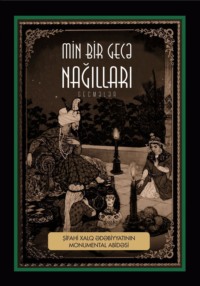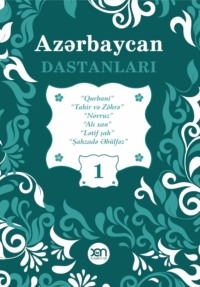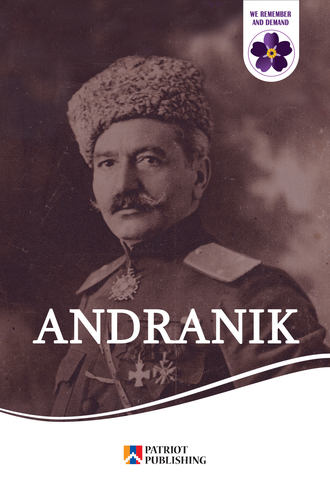 полная версия
полная версияAndranik. Armenian Hero

Republic of Armenia
Andranik
Andranik
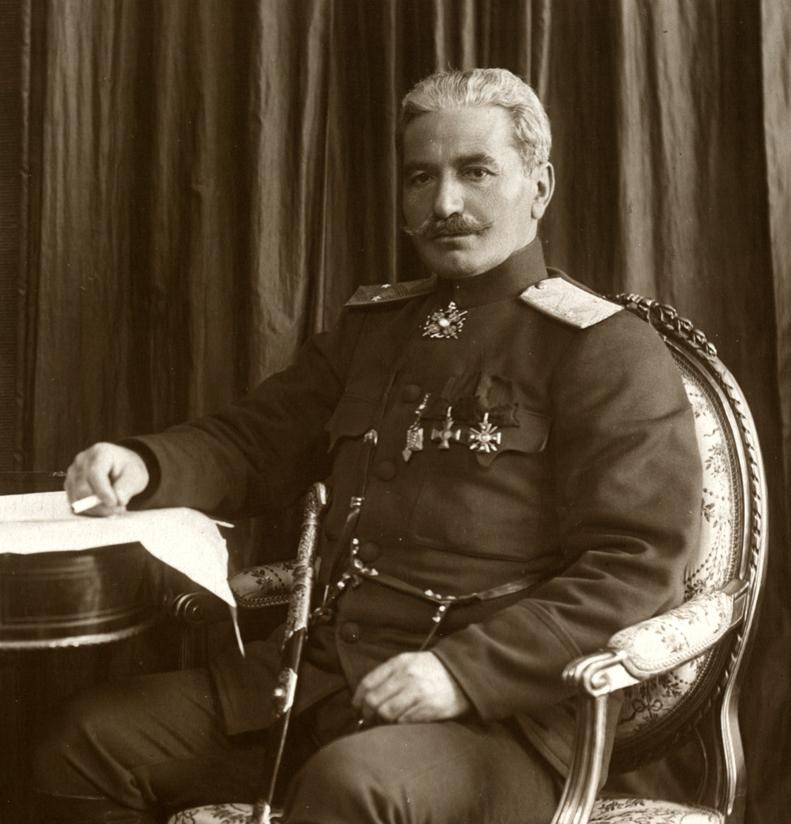
General Andranik c.1920
Andranik Ozanian, commonly known as Andranik (Armenian: Անդրանիկ; 25 February 1865 – 31 August 1927) was an Armenian military commander and statesman, the best known fedayi and a key figure of the Armenian national liberation movement. He became active in an armed struggle against the Ottoman government and Kurdish irregulars in the late 1880s. He joined the Armenian Revolutionary Federation (Dashnaktustyun) party and, along with other fedayi (militias), sought to defend the Armenian peasantry living in their ancestral homeland, an area known as Turkish (or Western) Armenia – at the time part of the Ottoman Empire. His revolutionary activities ceased and he left the Ottoman Empire after the unsuccessful uprising in Sasun in 1904. In 1907, Andranik left Dashnaktustyun because he disapproved of its cooperation with the Young Turks, a party which years later perpetrated the Armenian Genocide. Between 1912 and 1913, together with Garegin Nzhdeh, Andranik led a few hundred Armenian volunteers within the Bulgarian army against the Ottomans during the First Balkan War.
From the early stages of World War I, Andranik commanded the first Armenian volunteer battalion and led them within the Russian Imperial army against the Ottoman Empire. After the Revolution of 1917, the Russian army retreated and left the Armenian irregulars outnumbered against the Turks. Andranik led the defense of Erzurum in early 1918, but was forced to retreat eastward. By May 1918, Turkish forces stood near Yerevan – the future Armenian capital. The Dashnak-dominated Armenian National Council declared the independence of Armenia and signed the Treaty of Batum with the Ottoman Empire, by which Armenia gave up its rights to Western Armenia. Andranik never accepted the existence of the First Republic of Armenia because it included only a small part of the area many Armenians hoped to make independent. Andranik, independently from the Republic of Armenia, fought in Zangezur against the Azerbaijani and Turkish armies and helped to keep it within Armenia.
Andranik left Armenia in 1919 due to disagreements with the Armenian government and spent his last years of life in Europe and the United States seeking relief for Armenian refugees. He settled in Fresno, California in 1922 and died five years later in 1927. Andranik is greatly admired as a national hero by Armenians; numerous statues of him have been erected in several countries. Streets and squares were named after Andranik, and songs, poems and novels have been written about him, making him a legendary figure in Armenian culture.
Early life
Andranik Ozanian was born on 25 February 1865, in Shabin-Karahisar, Sivas Vilayet, Ottoman Empire – today in Turkey's Giresun Province – to Mariam and Toros Ozanian. Andranik means "firstborn" in Armenian. His paternal ancestors came from the nearby Ozan village in the early 18th century and settled in Shabin-Karahisar to avoid persecution from the Turks. His ancestors took the surname Ozanian in honor of their hometown. Andranik's mother died when he was one year old and his elder sister Nazeli took care of him. Andranik went to the local Musheghian School from 1875 to 1882 and thereafter worked in his father's carpentry shop. He married at the age of 17, but his wife died a year later while giving birth to their son – who also died days after the birth.
An undated photo of Andranik holding a rifle
The situation of the Armenians in the Ottoman Empire had worsened under the reign of Abdul Hamid II, who sought to unify all Muslims under his rule. In 1882, Andranik was arrested for assaulting a Turkish gendarme for mistreating Armenians. With the help of his friends, he escaped from prison. He settled in the Ottoman capital Constantinople in 1884 and stayed there until 1886, working as a carpenter. He began his revolutionary activities in 1888 in the province of Sivas. Andranik joined the Hunchak party in 1891. He was arrested in 1892 for taking part in the assassination of Constantinople's police chief, Yusup Mehmet Bey – known for his anti-Armenianism – on 9 February.Andranik once again escaped from prison. In 1892, he joined the newly created Armenian Revolutionary Federation (ARF or Dashnaktsutyun). During the Hamidian massacres, Andranik with other fedayi defended the Armenian villages of Mush and Sasun from attacks of the Turks and the Kurdish Hamidiye units. The massacres, which occurred between 1894 and 1896 and are named after Sultan Abdul Hamid II, killed between 80,000 and 300,000 people.
In 1897, Andranik went to Tiflis – the largest city of the Caucasus and a major center of Armenian culture at the time – where the ARF headquarters was located. Andranik returned to Turkish Armenia "entrusted with extensive powers, and with a large supply of arms" for the fedayi.Several dozen Russian Armenians joined him, with whom he went to the Mush-Sasun area where Aghbiur Serob was operating.Serob's forces had already established semi-independent Armenian areas by expelling the Ottoman government representatives.
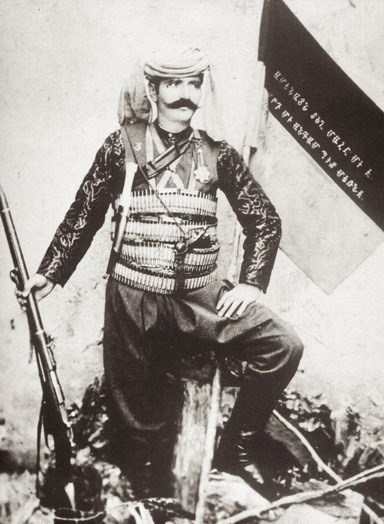
An undated photo of Andranik holding a rifle
Leader of the fedayi
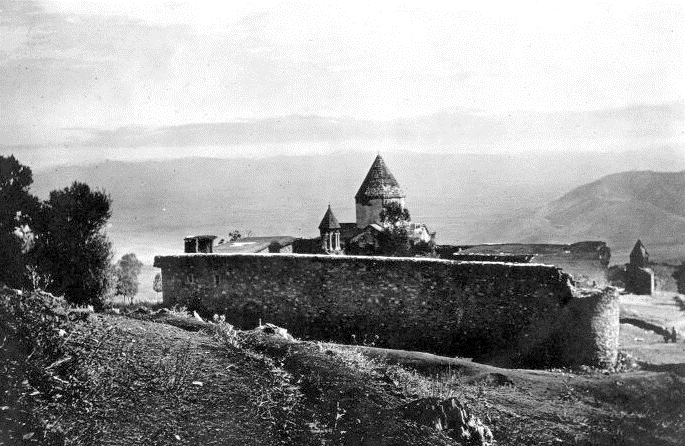
The Holy Apostles Monastery of Mush
Aghbiur Serob, the main leader of the fedayi in the 1890s, was killed in 1899 by a Kurdish chieftain, Bushare Khalil Bey.Months later, Bey committed further atrocities against the Armenians by killing a priest, two young men and 25 women and children in Sasun's village of Talvorik. Andranik replaced Serob as the head of the Armenian irregular forces "with 38 villages under his command" in the Mush-Sasun region of Western Armenia, where a "warlike semi-independent Armenian peasantry" lived. Andranik sought to kill Bey; he captured and reportedly decapitated the chieftain, and took the medal given to Bey by Sultan Abdul Hamid II. Andranik thus earned an undisputed authority among his fedayi.
Although small groups of Armenian fedayi conducted an armed struggle against the Ottoman state and the Kurdish tribes, the situation in Turkish Armenia deteriorated as the European powers stood indifferent to the Armenian Question. Article 61 of the 1878 Treaty of Berlin intended the Ottoman government to "carry out, without further delay, the improvements and reforms demanded by local requirements in the provinces inhabited by the Armenians, and to guarantee their security against the Circassians and Kurds" remained unimplemented.According to Christopher J. Walker, the attention of the European powers was on Macedonia, while Russia was "in no mood for reactivating the Armenian question".
Battle of Holy Apostles Monastery
In November 1901 the fedayi clashed with the Ottoman troops in what later became known as the Battle of Holy Apostles Monastery. One of the best-known episodes of Andranik's revolutionary activities, it was an attempt by the Ottoman government to suppress his activities. Since Andranik had gained more influence over the region, more than 5,000 Turkish soldiers were sent after him and his band. The Turks chased and eventually circled him and his men, numbering around 50, at the Arakelots (Holy Apostles) Monastery in early November. A regiment under the command of Ferikh Pasha and Ali Pasha besieged the fort-like monastery. The Turkish generals leading the army of twelve hundred men asked the fedayi to negotiate their surrender.
After weeks of resistance and negotiations – in which Armenian clergy and the headman of Mush and foreign consuls took part – Andranik and his companions left the monastery and fled in small groups. According to Leon Trotsky, Andranik – dressed in the uniform of a Turkish officer – "went the rounds of the entire guard, talking to them in excellent Turkish", and "at the same time showing the way out to his own men." After breaking through the siege of the monastery, Andranik gained legendary stature among provincial Armenians. He became so popular that the men he led came to refer to him always by his first name. Andranik intended to attract the attention of the foreign consuls at Mush to the plight of the Armenian peasants and to provide hope for the oppressed Armenians of the eastern provinces. According to Trotsky, Andranik's "political think took shape in a setting of Carbonarist activity and diplomatic intrigue."
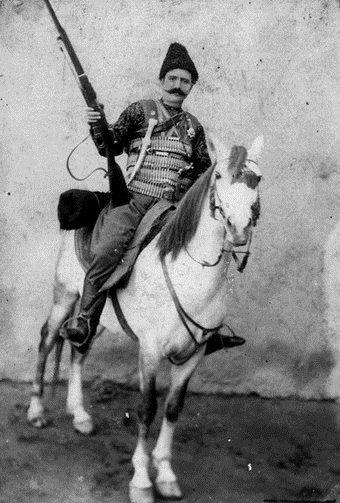
Andranik on his horse, early 1900s
1904 Sasun uprising and exodus
In 1903, Andranik demanded the Ottoman government stop the harassment of Armenians and implement the reforms in the Armenian provinces. Most fedayi were concentrated in mountainous Sasun, an area of about 12,000 km2 (4,600 sq mi) with an overwhelming Armenian majority – 1,769 Armenian and 155 Kurdish households – which was traditionally considered their main operational area. The region was in "a state of revolutionary turmoil" because the local Armenians had refused to pay taxes for the past seven years. Andranik and tens of other fedayi – including Hrayr and Sebouh – held a meeting at Gelieguzan village in the third quarter of 1903 to manage the future defense of the Armenian villages from possible Turkish and Kurdish attacks. Andranik suggested a widespread uprising of the Armenians of Taron and Vaspurakan; Hrayr opposed his view and suggested a small, local uprising in Sasun, because the Armenian irregulars lacked resources. Hrayr's suggestion was eventually approved by the fedayi meeting. Andranik was chosen as the main commander of the uprising.
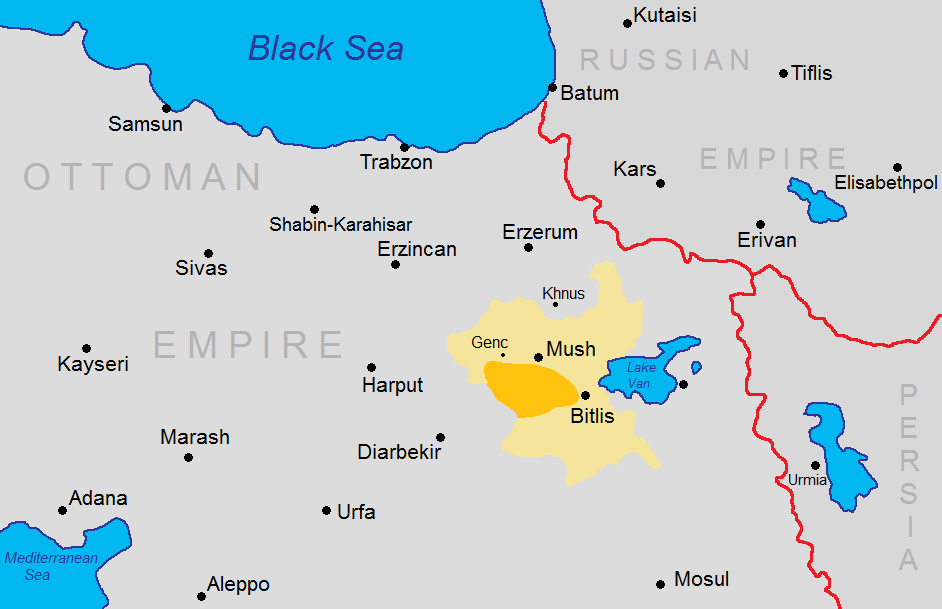
The location of the Sasun uprising (orange) and the Bitlis Vilayet (yellow).
The first clashes took place in January 1904 between the fedayi and Kurdish irregulars supported by the Ottoman government. The Turkish offensive started in early April with an estimated 10,000 to 20,000 soldiers and 7,000 Kurdish irregulars put against 100 to 200 Armenian fedayi and 700 to 1,000 local Armenian men. Hrayr was killed during the intense fighting; Andranik survived and resumed the fight. Between 7,000 and 10,000 Armenian civilians were killed during the two months of the uprising, while about 9,000 were left homeless. Around 4,000 Sasun villagers were forced into exile after the uprising.
After weeks of fighting and cannon bombardment of the Armenian villages, the Ottoman forces and Kurdish irregulars suppressed the uprising by May 1904; they outnumbered the Armenian forces several times. Minor clashes occurred thereafter. According to Christopher J. Walker, the fedayi came "near to organising an uprising and shaking Ottoman power in Armenia", but "even then it was unthinkable that the empire would lose any of her territory, since the idea of intervention was far from Russia". Trotsky wrote that international attention was on the Russo-Japanese War and the uprising went largely unnoticed by the European powers and Russia.
In July–August 1904, Andranik and his fedayi reached Lake Van and got to Aghtamar Island with sailing ships.They escaped to Persia via Van in September 1904,"leaving little more than a heroic memory. Trotsky states that they were forced to leave Turkish Armenia to avoid further killings of Armenians and to lower the tensions, while Tsatur Aghayan wrote that Andranik left the Ottoman Empire because he sought to "gather new resources and find practical programs" for the Armenian struggle.
Andranik in Bulgaria c. 1913
From Persia, Andranik moved to the Caucasus, where he met the Armenian leaders in Baku and Tiflis. He then left Russia and traveled to Europe, where he was engaged in advocacy in support of the Armenians' national liberation struggle. In 1906 in Geneva, he published a book on military tactics. Most of the work was about his activities and the strategies he used during the 1904 Sasun uprising.
In February–March 1907, Andranik went to Vienna to participate in the fourth ARF Congress. The ARF, which had been associating with Turkish immigrant political groups in Europe since 1902, discussed and approved the negotiations with the Young Turks – who later perpetrated the Armenian Genocide – to overthrow Sultan Abdul Hamid II. Andranik strongly denounced this cooperation and left the party. In 1908, the ARF asked Andranik to move to Constantinople and nominate his candidacy in the Ottoman parliament election, but he declined the offer, saying "I don't want to sit there and do nothing".Andranik distanced himself from active political and military affairs for several years.
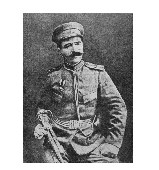
Immigration and conflict with the ARF
First Balkan War
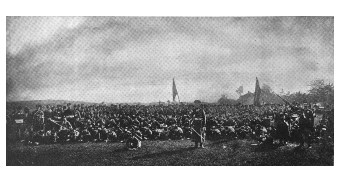
ЯArmenian volunteers under Andranik during the Balkan War
In 1907 Andranik settled in Sofia, where he met the leaders of the Internal Macedonian Revolutionary Organization – including revolutionary Boris Sarafov – and the two pledged to work jointly for the oppressed peoples of Armenia and Macedonia.During the First Balkan War (1912–13), Andranik led a company of 230 Armenian volunteers – part of the Macedonian-Adrianopolitan Volunteer Corps of Aleksandar Protogerov within the Bulgarian army – against the Ottoman Empire. He shared the command with Garegin Nzhdeh. On the opposite side, approximately 8,000 Armenians fought for the Ottoman Empire.Andranik was given the rank of a first lieutenant by the Bulgarian government. He distinguished himself in several battles, including in the Battle of Merhamli, when he helped the Bulgarians to capture Turkish commander Yaver Pasha. Andranik was honored with the Order of Bravery by General Protogerov in 1913. However, Andranik disbanded his men in May 1913, and foreseeing the war between Bulgaria and Serbia he "retired to a village near Varna, and lived as a farmer until August 1914".
World War I
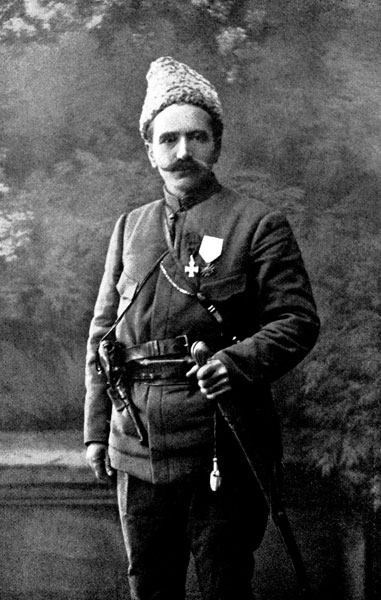
Andranik as the commander of the first Armenian volunteer battalion
With the outbreak of World War I in July 1914 between Russia, France and Britain on one side and Germany, the Ottoman Empire and Austria on the other, Andranik left Bulgaria for Russia. He was appointed the commander of the first Armenian volunteer battalion by the Russian government. From November 1914 to August 1915, Andranik took part in the Caucasus Campaign as the head commander of the first Armenian battalion of about 1,200 volunteers within the Imperial Russian Army. Andranik's battalion particularly stood out at the Battle of Dilman in April 1915. By the victory at Dilman, the Russian and Armenian forces under the command of General Nazarbekian, effectively stopped the Turks from invading the Caucasus via Iranian Azerbaijan.
Through 1915, the Armenian Genocide was underway in the Ottoman Empire. By the end of the war, virtually all Armenians living in their ancestral homeland were either dead or forced into exile by the Ottoman government. An estimated 1.5 million Armenians died in the process, ending two thousand years of Armenian presence in Western Armenia. The only major resistance to the Turkish atrocities took place in Van. The Turkish army besieged the city but the local Armenians, under the leadership of Aram Manukian, kept them out until the Armenian volunteers reached Van, forcing the Turks to retreat. Andranik with his unit entered Van on 19 May 1915. Andranik subsequently helped the Russian army to take control of Shatakh, Moks and Tatvan on the southern shore of Lake Van. During the summer of 1915, the Armenian volunteer units disintegrated and Andranik went to Tiflis to recruit more volunteers and continued the combat from November 1915 until March 1916. With Andranik's support, the city of Mush was captured by Russians in February 1916. In recognition of lieutenant general Theodore G. Chernozubov, the successes of Russian army in numerous locations were significantly associated with the fighting of the first Armenian battalion, headed by Andranik. Chernozubov praised Andranik as a brave and experienced chief, who well understood the combat situation; Chernozubov described him as always at the head of militia, enjoying great prestige among the volunteers.
The situation drastically changed in 1916 when the Russian government ordered the Armenian volunteer units to be demobilized and prohibited any Armenian civic activity.Andranik resigned as the commander of the first Armenian battalion. Despite the earlier Russian promises, their plan for the region was to make Turkish Armenia an integral part of Russia and "possibly repopulate by Russian peasants and Cossacks". Richard Hovannisian wrote that because the "Russian armies were in firm control of most of the Armenian plateau by the summer of 1916, there was no longer any need to expend niceties upon the Armenians". According to Tsatur Aghayan, Russia used the Armenian volunteers for its own interests. Andranik and other Armenian volunteers, disappointed by the Russian policy, left the front in July 1916.

Andranik with his men during World War I
Russian Revolution and Turkish reoccupation

The greatest extent of the Russian occupation of Turkish Armenia during WWI, September 1917. The area was reoccupied by the Turks between February and April 1918.
The February Revolution was positively accepted by the Armenians because it ended the autocratic rule of Nicholas II. The Special Transcaucasian Committee (known as OZAKOM) was set up in the South Caucasus by the Russian Provisional Government. In April 1917, Andranik initiated the publication of the newspaper Hayastan (Armenia) in Tiflis. Vahan Totovents became the editor of this non-partisan, Turkish Armenian-orientated newspaper. Until December 1917, Andranik remained in the South Caucasus where he sought to help the Armenian refugees from the Ottoman Empire in their search for basic needs. The provisional government decree of 9 May 1917 put Turkish Armenia under civil administration, with Armenians holding key positions. About 150,000 local Armenians began to rebuild devastated Turkish Armenia; however the Russian army units gradually disintegrated and many soldiers deserted and returned to Russia.

General Andranik Ozanian, wearing his uniform and medals with a papakha hat
After the 1917 October Revolution, the chaotic retreat of Russian troops from Turkish Armenia escalated.[64] Bolshevik Russia and the Ottoman Empire signed the Armistice of Erzincan on 5 December 1917, ending the hostilities. The Soviet Russian government formally acknowledged the right of self-determination of the Turkish Armenians in January 1918, but on 3 March 1918, Russia signed the Treaty of Brest-Litovsk with the Central Powers, ceding Turkish Armenia and large areas in Eastern Europe to concentrate its forces against the Whites in the Russian Civil War.
In December 1917, because the Russian divisions were deserting the region en masse, the Russian command authorized the formation of the Armenian Army Corps under the Transcaucasian Commissariat. Under the command of General Nazarbekian, the Corps was positioned in the front line from Van to Erzincan – a city of around about 20,000 people. Two of the Corps' three divisions were made up of Russian Armenians, while Andranik commanded the Turkish (Western) Armenian division. The Georgian forces patrolled the area between Erzincan and the Black Sea. Hovannisian states that the only "several thousand men now defended a 300-mile front formerly secured by a half million Russian regulars". Since December 1917, Andranik commanded the Armenian forces in Erzurum. In January 1918, he was appointed commander of the Western Armenian division of the Armenian Army Corps and given the rank of major-general by the Caucasus Front command. Andranik was unable to defend Erzurum for long and the outnumbering Turks captured the city on 12 March 1918, forcing the Armenians to evacuate.
While the Transcaucasian delegation and the Turks were holding a conference in Trebizond, through March and April the Turkish forces, according to Walker, "overran the temporary establishment of Armenian rule in Turkish Armenia, extinguishing the hope so recently raised". Hovannisian wrote, "the battle for Turkish Armenia had been quickly decided; the struggle for Russian Armenia was now at hand". After the Turks captured Erzurum, the largest city in Turkish Armenia, Andranik retreated through Kars, passed through Alexandropol and Jalaloghly, and arrived in Dsegh by 18 May. By early April 1918, the Turkish forces had reached the pre-war international borders. Andranik and his unit in Dsegh were not able to take part in the battles of Sardarabad, Abaran and Karakilisa.
First Republic of Armenia
Since the Ottoman forces were effectively stopped at Sardarabad, the Armenian National Council declared the independence of the Russian Armenian lands on 28 May 1918. Andranik condemned this move and denounced the Armenian Revolutionary Federation. Angry with the Dashnaks, he favored good relations with Bolshevik Russia instead. Andranik refused to acknowledge the Republic of Armenia because according to the Treaty of Batum it "was only a dusty province without Turkish Armenia whose salvation Armenians had been seeking for 40 years." In early June, Andranik departed from Dilijan with thousands of refugees; they traveled through Yelenovka, Nor Bayazet and Daralagyaz, and arrived in Nakhichevan on 17 June.He subsequently tried to help the Armenian refugees from Van at Khoy, Iran. He sought to join the British forces in northern Iran, but after encountering a large number of Turkish soldiers he retreated to Nakhichevan. On 14 July 1918, he proclaimed Nakhichevan an integral part of Russia. His move was welcomed by Armenian Bolshevik Stepan Shahumyan and Soviet leader Vladimir Lenin.
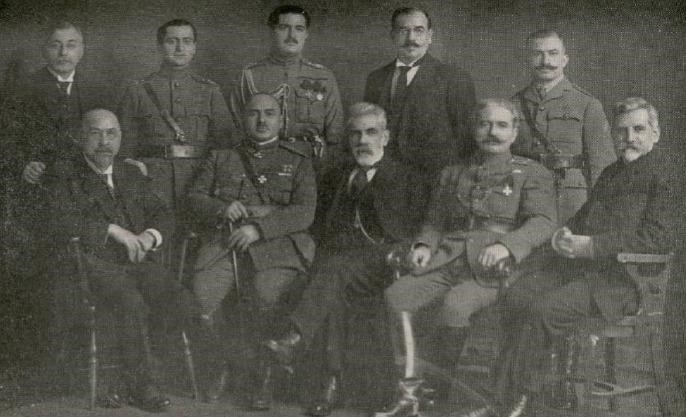
Republic of Armenia delegation to the United States. Andranik is second from the bottom right.
Zangezur
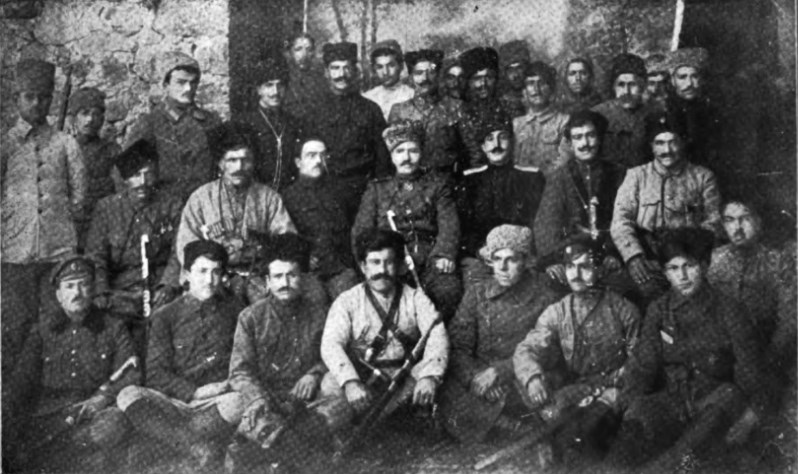
Andranik with the commanders of the Special Striking Division in Zangezur, 1918
As the Turkish forces moved towards Nakhichevan, Andranik with his Armenian Special Striking Division moved to the mountainous region of Zangezur to set up a defense. By mid-1918, the relations between the Armenians and Azeris in Zangezur had deteriorated. Andranik arrived in Zangezur at a critical moment with around 30,000 refugees and an estimated force of between 3,000 and 5,000 men. He established effective control of the region by September. The role of Zangezur was crucial because it was a connection point between Turkey and Azerbaijan. Under Andranik, the region became one of the last centers of Armenian resistance after the Treaty of Batum.
Andranik's irregulars remained in Zangezur surrounded by Muslim villages that controlled the key routes connecting the different parts of Zangezur.According to Donald Bloxham, Andranik initiated the change of Zangezur into a solidly Armenian land by destroying Muslim villages and trying to ethnically homogenize key areas of the Armenian state. In late 1918, Azerbaijan accused Andranik of killing innocent Azerbaijani peasants in Zangezur and demanded that he withdraw Armenian units from the area. Antranig Chalabian wrote that, "Without the presence of General Andranik and his Special Striking Division, what is now the Zangezur district of Armenia would be party of Azerbaijan today. Without General Andranik and his men, only a miracle could have saved the sixty thousand Armenian inhabitants of the Zangezur district from complete annihilation by the Turko-Tatar forces in the fall of 1918"; he further stated that Andranik "did not massacre peaceful Tatars". Andranik's activities in Zangezur were protested by Ottoman general Halil Pasha, who threatened the Dashnak government with retaliation for Andranik's actions. Armenia's Prime Minister Hovhannes Katchaznouni said he had no control over Andranik and his forces.



